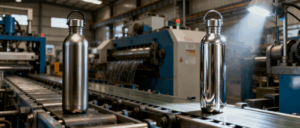In the debate of 201 Stainless Steel vs 304 Stainless Steel, it’s important to know that one of the most popular materials in the drinkware industry is stainless steel, which is particularly used in the manufacture of insulated bottles, thermos flasks, and reusable sports water bottles. The most widely used grades of stainless steel are 201 and 304. Despite their apparent similarities, they differ greatly in terms of cost, performance, and durability.
This article helps importers and buyers choose the best drinkware suppliers by outlining the differences between 201 and 304 stainless steel based on cost, applications, safety, corrosion resistance, and material composition. When considering 201 Stainless Steel vs 304 Stainless Steel, understanding these differences is crucial.
201 and 304 stainless steel: what are they?
| Stainless Steel Grade | Main Alloy Elements | Feature Summary |
|---|---|---|
| 201 | Lower Nickel, Higher Manganese | Lower cost, lower corrosion resistance |
| 304 | 8–10.5% Nickel, 18–20% Chromium | Food-grade, high corrosion resistance |
The austenitic stainless steel family includes both 201 and 304, but 304 has more nickel, which makes it more stable and rust-resistant, which is crucial for long-term use in drinkware. This is another critical point in the 201 Stainless Steel vs 304 Stainless Steel comparison.
Important Distinctions Between Stainless Steel Types 201 and 304
1. Resistance to corrosion
Because of its superior anti-rust qualities, 304 stainless steel is perfect for outdoor use, hot liquids, and acidic beverages. Over time, 201 stainless steel is more prone to rust, particularly in moist or salty conditions (such as coastal areas). This makes corrosion resistance a key factor in the 201 Stainless Steel vs 304 Stainless Steel debate.
✅ Suggestion: 304 stainless steel is highly advised for goods going to South America, Southeast Asia, and Africa (regions with humid climates).
2. Safety of Food
304 stainless steel is widely used in kitchenware and drinkware and is certified food-grade globally. Although 201 stainless steel is safe for long-term use, its chemical stability is inferior to that of 304, highlighting another difference in the 201 Stainless Steel vs 304 Stainless Steel comparison.
✅ Select 304 stainless steel if your company sells premium insulated bottles, kid-safe bottles, or certified food items.
Durability & Longevity
| Feature | 201 Stainless Steel | 304 Stainless Steel |
|---|---|---|
| Durability | Good | Excellent |
| Lifespan | 2–3 years | 5–8 years |
| Dent Resistance | Harder but brittle | Strong and resilient |
4. Price Comparison
| Item | Price Level |
|---|---|
| 201 stainless steel | ★ Budget-friendly |
| 304 stainless steel | ★★★ Higher cost but worth it |
201 stainless steel is mostly used for inexpensive goods. When product quality, customer satisfaction, and brand reputation are important, 304 is the preferred option.
How to Tell the Difference Between 201 and 304 Stainless Steel
| Test Method | Result |
|---|---|
| Magnet Test | 304: Weak or no magnetism |
| Saltwater Test | 201 shows slight rust spots |
| Weight | 304 is slightly heavier |
| Price | 304 is more expensive |
Conclusion: Which Stainless Steel Should You Choose?
| Decision Priority | Best Choice |
|---|---|
| Cost | 201 |
| Long-term quality | 304 ✅ |
| Food safety | 304 ✅ |
| Export markets and branding | 304 ✅ |
304 stainless steel is the most dependable choice for private label and wholesale drinkware in order to meet international customer standards, enhance product reputation, and lower returns.
Diller Stainless Steel Series
As a professional insulated water bottle manufacturer in China, Diller offers products in 304 and 316 stainless steel. Our products include:
✅ Vacuum Insulated Bottles
✅ Stainless Steel Sports Water Bottles
✅ Coffee Mugs
✅ Travel Mugs
✅ Custom Logo OEM & ODM
Diller products are exported to South America, Southeast Asia, East Asia, Oceania, and Africa. We offer factory-direct prices and global shipping. Diller water bottles prioritize quality and do not use 201 stainless steel, making the choice clear when considering 201 Stainless Steel vs 304 Stainless Steel.

